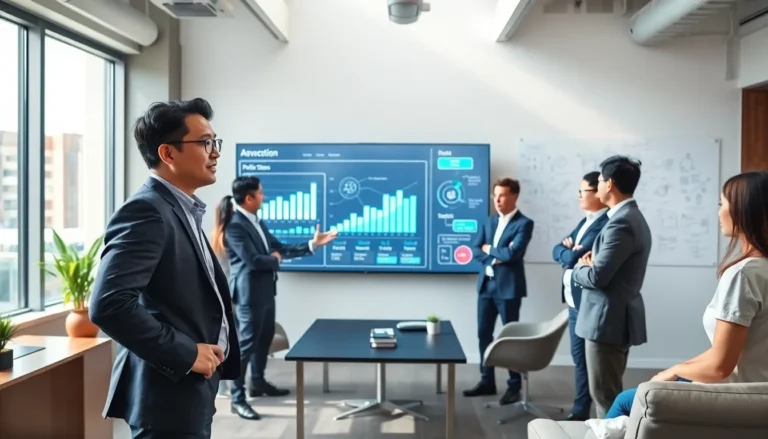Imagine juggling your taxes, public records, and municipal services, all while dealing with a spreadsheet from the 1970s. Enter GovTech, the superhero of the public sector, swooping in to rescue governments from the clutches of outdated technology. This isn’t just a fancy buzzword: it’s a revolution in how governments deliver services, engage citizens, and manage resources. By leveraging modern technology, GovTech transforms bureaucracy into a streamlined, user-friendly experience. Curious about how this all works? Let’s dive right in.
Table of Contents
ToggleUnderstanding GovTech

GovTech refers to the intersection of government operations and innovative technology solutions designed to enhance public administration and service delivery. This concept encompasses a broad range of technologies, from software that simplifies tax collection to platforms that help citizen engagement. It serves as a bridge for governments to harness the power of technology to respond better and faster to the needs of their citizens.
At its core, GovTech focuses on improving efficiency, transparency, and accessibility within government operations. This evolution acknowledges that citizens expect services that are just as fast and intuitive as those offered by the private sector. So, understanding GovTech begins with recognizing its primary goal: to empower governments to deliver public services in a way that meets the modern citizen’s expectations.
The Role of Technology in Government
The role of technology in government cannot be overstated. It serves as the backbone of numerous public services, enabling processes that were once cumbersome and opaque to become user-friendly and transparent. Technologies like cloud computing, data analytics, and mobile applications equip government agencies to address a myriad of challenges efficiently.
One key area is data management. By harnessing big data, governments can gain insights into public needs, optimize resource allocation, and predict future demands. For instance, data analytics allows city planners to understand traffic patterns better and make informed decisions about urban infrastructure.
Also, technology enhances communication channels between citizens and government agencies. Online portals and mobile apps offer citizens easy avenues to access information, report issues, or inquire about services. As a result, this fosters a relationship built on trust and accountability, enhancing civic engagement in community decision-making.
Key Components of GovTech Solutions
GovTech solutions encompass various components that work synergistically to improve public sector operations. These can be broadly categorized into three main areas:
- Digital Services: These include online platforms that allow governments to provide services directly to citizens. Think of it as a one-stop-shop for various public services, everything from renewing a driver’s license to filing taxes.
- Data Analytics: This component involves collecting, analyzing, and applying data to inform decision-making and policy development. Governments use data mining techniques to uncover trends, enabling proactive solutions to social and economic issues.
- Cybersecurity: As reliance on technology grows, so does the importance of protecting sensitive information. Robust cybersecurity protocols are essential to safeguard both governmental data and citizen privacy, ensuring that trust remains intact.
Together, these components create an integrated ecosystem, allowing governments to manage operations efficiently and improve service delivery.
Benefits of GovTech Adoption
The adoption of GovTech brings a wealth of benefits for both citizens and government agencies alike. Here are some of the most significant advantages:
- Enhanced Efficiency: Streamlined processes mean tasks that once took weeks can be completed in days, or even hours. This responsiveness not only saves time but also budget resources.
- Transparency and Accountability: Many GovTech solutions include features that allow for public tracking of governmental actions. This builds trust among citizens who can hold their leaders accountable for their decisions.
- Cost Savings: By automating routine tasks, governments can reduce operational costs while reallocating resources where they’re most needed. Hence, taxpayers benefit from improved services without increased taxation.
- Increased Engagement: With accessible platforms and channels for communication, citizens feel more involved in the policymaking process. Effective engagement enhances community involvement and fosters a sense of belonging.
Challenges in Implementing GovTech
Even though the myriad benefits, implementing GovTech solutions is not without its challenges. Here are some hurdles that governments often face:
- Resistance to Change: Transitioning to new technologies can meet resistance from within the government itself. Employees who are comfortable with traditional practices may be hesitant to embrace new tech solutions.
- Budget Constraints: While long-term savings are likely, the initial investment for adopting advanced technologies can be daunting for many governments facing budget cuts.
- Integration Issues: Many governments use outdated infrastructure that may not easily integrate with modern technologies. Finding seamless ways to blend old systems with new innovations is crucial for a successful transition.
- Cybersecurity Threats: With the rise of digital solutions comes the increased risk of cyber-attacks. Ensuring robust cybersecurity measures are in place becomes paramount to protect sensitive information.
Future Trends in GovTech
The future of GovTech is poised for exciting advancements. Emerging technologies such as artificial intelligence (AI), machine learning, and blockchain will play critical roles in reshaping the public sector.
AI and machine learning can enable governments to automate complex processes, enhancing decision-making capabilities based on predictive analytics. Imagine a system that could forecast public health crises or predict traffic congestion.
Blockchain technology offers solutions for greater security and transparency, especially about public records and voting systems. By decentralizing data management, blockchain can enhance trust among citizens in their government’s actions.
Also, the focus on citizen-centered design in GovTech solutions will increasingly prioritize accessibility and user experience. Governments will likely place an emphasis on making services not only high-tech but also easy to navigate for all citizens, making civic engagement and service delivery universally accessible.









